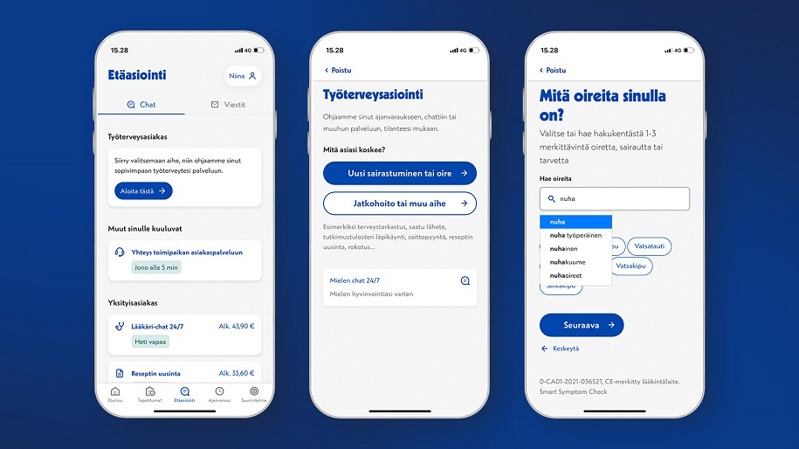An efficient or a humanely efficient organization? A well-functioning organization requires both kinds of efficiency
An organization is efficient when it takes into account both operational and humane efficiency in its operations. Humane efficiency takes people’s psychological needs into consideration – and that is why it is worth putting its ideas into practice now.

Operational efficiency, which ensures both the efficiency and the performance of the company, is a familiar concept for many in management roles.
On the other hand, humane efficiency is overlooked in too many organizations. Humane efficiency describes the psychological dynamics and human factors of an organization: how, for example, a sense of community is realized within the organization and how the people working in the organization can be motivated.
Outi Ikonen, Terveystalo’s Chief Organizational Psychologist, points out that an organization that strives for efficiency should invest in both operational and humane efficiency.
“Without one there cannot be the other. Taking humane efficiency into account increases the growth of the organization’s productivity, the success of various changes and the well-being of employees,” says Ikonen.
The world is changing – pay attention to how changes are made
Adopting the ideas of humane efficiency is particularly useful when changes are being made.
“For example, uncertainty has increased enormously during the COVID-19 crisis, and it is now even more important to take human factors into account. If no attention is paid to human factors, efficiency will definitely not increase and may even decrease,” says Ikonen.
According to Ikonen, the success of various organizational changes also depends to a large extent on how well humane efficiency is realized within the organization.
“The change process can be very good in terms of operational efficiency, but if humane efficiency is not taken into account, employees will not be motivated and, at worst, trust will be undermined.”
The step toward humane efficiency does not have to be taken alone.
“The goal of the Humane Efficiency coaching offered by Terveystalo is to increase the organization’s competence in managing human factors and, through that, improve the entire organization’s productivity and the well-being of its employees,” Outi Ikonen says.
The management’s example matters
Building a healthy and humane organization starts with the senior management clarifying the target situation.
“Supervisors should be aware of the effects of humane efficiency, but the actions of the management team are particularly important. If the senior management does not make a strong commitment to the issue and act as an agent of change, humane efficiency will not be improved,” Ikonen says.
The process itself is not always easy. In order for an organization to develop, the management needs a genuine understanding of the current state of the organization’s humane efficiency and the target situation toward which it intends to proceed.
“Organizations often invest in well-being at work, but the projects end up being too unconnected. In order for humane efficiency to become a reality, it is important that good practices are properly embedded in the culture and structures of the organization. In this way, they will eventually become the actual common practices of the organization,” Ikonen says.
Five steps toward a humanely efficient workplace
- Let humanity show. Be yourself. If you work in a supervisory role, it is good to think about how much you can let your feelings show. However, keep in mind that supervisors and managers have their own strengths and vulnerabilities, which should not be hidden unnecessarily.
- Remember balance. Lead change, inspire, and encourage, while also ensuring sufficient internal stability, routines, and smoothness of work.
- Boldly combine humane and operational leadership. A good manager of people can also be an excellent manager of performance at the same time. Humane efficiency and operational efficiency are not mutually exclusive.
- Learn to understand. Listen to and understand not only things but also people’s experiences and feelings. A leader should use their own example to create a psychologically safe work community in which asking, wondering and mistakes are allowed.
- Set an example. Set limits that support well-being for yourself and others and ensure a good work–life balance. Supervisors should keep in mind that if they work too hard, they will set an example for employees that they should work just as hard. At worst, overachievement undermines humane efficiency.
Learn more about Humane Efficiency
Lue lisää aiheesta

Give yourself time to recover - activate Rela massage therapists summer benefit for your organisation!
With the arrival of summer, it's a good time to relax and let our massage professionals take the stress out of your muscles too. Terveystalo Rela massage therapists' familiar summer benefit for occupational health clients helps your employees recover with massage, nationwide at our nearly 80 massage clinics.

Business decision-makers choose Terveystalo as the most popular occupational health partner
In Kantar's corporate image survey*, HR managers and business managers responsible for the procurement of occupational health services assessed the awareness and preference of different service providers, and rated the factors influencing the procurement decision. According to the survey, Terveystalo is the first provider that comes to mind and the most popular choice as an occupational health partner.

Effective help from occupational health brief psychotherapy more smoothly
Terveystalo's Näin Suomi voi Study* found that although mental health challenges are affecting more and more people, the number of absences due to illness has remained relatively stable in recent years. Research has shown that one of the main reasons for the effectiveness of treatment for mental health problems is well-functioning and rapid referral to treatment in line with Current Care recommendations.

Näin Suomi voi - a review of the health of working-age people
In 2023, Finland returned to pre-Covid19 levels of morbidity. However, Terveystalo's data on "Näin Suomi voi (How Finland is doing)"* reveals a significant change in the nature of sickness absence, which reflects a change in the culture of work performance management and a change in the way work is done. Despite the decline in sickness absence rates, the poor general health of the working-age population is a cause for concern for health professionals.

How to make working life humanly efficient and sustainable?
What should workplaces do differently to make employees more productive? The pace of work is getting faster and faster, but is it still sensible and sustainable to work at such a fast pace? How can we build a working life that supports people's well-being in a sustainable way? Answers to all these questions are being sought in a year-long project launched by Terveystalo's Organisational Psychology team, which will examine the state of Finnish working life from the perspectives of human and organisational well-being, human efficiency and sustainability.

Digital leadership in occupational health services: the benefits and customer experience of the Symptom assessment tool
The new Occupational Health steering model was introduced at the end of 2023 for all our occupational health clients. An integral part of the guidance model is the Symptom Assessment tool, which is used across digital channels to guide our occupational health clients to the right specialist, in the right channel and at the right time when they are ill. It also helps our professionals to prepare for the upcoming appointment, thus streamlining the client encounter.